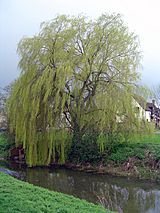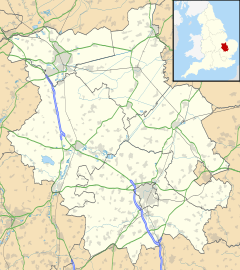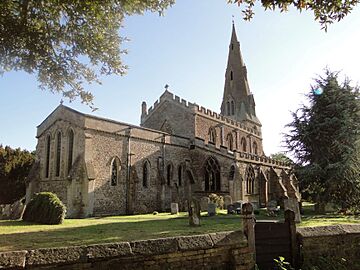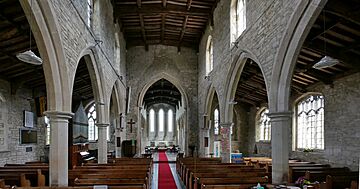Alconbury facts for kids
Quick facts for kids Alconbury |
|
|---|---|
 A Weeping Willow in Alconbury, taken from across Alconbury Brook |
|
| Population | 1,569 (2011) |
| OS grid reference | TL1875 |
| District | |
| Shire county | |
| Region | |
| Country | England |
| Sovereign state | United Kingdom |
| Post town | HUNTINGDON |
| Postcode district | PE28 |
| Dialling code | 01480 |
| Police | Cambridgeshire |
| Fire | Cambridgeshire |
| Ambulance | East of England |
| EU Parliament | East of England |
| UK Parliament |
|
Alconbury is a village and civil parish located in Cambridgeshire, England. It's part of Huntingdonshire, which is a special area within Cambridgeshire and also an old historic county.
Alconbury is about 5 kilometers (3 miles) north-west of the town of Huntingdon.
Contents
History of Alconbury
Alconbury is a very old village! It was first mentioned in a famous book called the Domesday Book in 1086. This book was like a big survey ordered by William the Conqueror to record everything in England.
In the Domesday Book, Alconbury was known as Acumesberie and Almundeburie. It had about 17.5 households back then.
The village church is named after St Peter and St Paul. A very important old road, the Great North Road, used to go right through Alconbury. This road connected London to the north of England.
Over the years, the roads around Alconbury have changed a lot. In 1964, a new bypass was built for the A1 road, which helped traffic flow better. Later, in 1998, part of this bypass became a motorway, the A1(M).
Did you know that the US Air Force had bases in Alconbury? They were here during World War II (from 1942 to 1945) and then again from 1953 to 1995.
Geography of Alconbury
Alconbury is in the Huntingdonshire district. The village gives its name to RAF Alconbury, which was a Royal Air Force base. A new housing and business area called Alconbury Weald is now being built on the old airfield.
The village is located near a very important spot where two major roads meet: the A1 (which goes north-south) and the A14 (which goes east-west). This makes Alconbury a key place for transport.
In 2005, there were ideas to turn the old RAF Alconbury airfield into a commercial airport just for cargo. However, these plans didn't happen.
Nearby villages to the east are Great Stukeley and Little Stukeley, often called "The Stukeleys." Just north of where the A1 and A14 roads meet is a place called Alconbury Hill.
 |
Buckworth | Alconbury Weston |  |
|
| Barham and Woolley | The Stukeleys | |||
| Ellington | Brampton |
Population and People
How Many People Live Here?
The number of people living in Alconbury has changed quite a bit over the years. From 1801 to 1901, the population was counted every ten years. The lowest number was 483 people in 1801, and the highest was 967 people in 1851.
Since 1901, a census (a count of the population) has been taken every ten years, except in 1941 because of the Second World War.
| Parish |
1911 |
1921 |
1931 |
1951 |
1961 |
1971 |
1981 |
1991 |
2001 |
2011 |
|---|---|---|---|---|---|---|---|---|---|---|
| Alconbury | 518 | 523 | 492 | 733 | 629 | 748 | 1,131 | 2,440 | 1,670 | 1,569 |
In 2011, Alconbury had 1,569 people living there. The village covers an area of about 3,067 acres (1,241 hectares). This means that in 2011, there were about 126 people living in each square kilometer (or 327 people per square mile).
What's in Alconbury? (Amenities)
Alconbury has many useful things for its residents. It has a Neighbourhood Watch group to help keep the community safe. For sports lovers, there's a cricket club and football teams. If you like to sing, there's a community choir!
The village also has a public house (a pub), a doctor's surgery for healthcare, and a post office. It's even where the local Member of Parliament (MP) lives! There's a Church of England primary school for younger students.
A service station near the A14 junction that closed in 2007 reopened in 2012 under new owners.
Alconbury hosts several fun events throughout the year. These include the Neighbourhood Watch Summer Fête, a Village Show, and a Harvest Supper. Every two years, they have a Christmas tree festival and a Scarecrow Festival, where people make cool scarecrows! There are also "open gardens" events where people can visit beautiful private gardens.
Alconbury is planned to be the end point for the new Cambridge Metro project. This project aims to make public transport better in the east of England.
See also
 In Spanish: Alconbury para niños
In Spanish: Alconbury para niños




